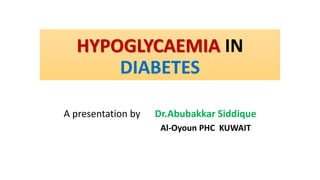This document discusses hypoglycemia in diabetes, including its definition, symptoms, causes, treatment, and the role of technology in prevention. Hypoglycemia is defined as a low blood glucose level below 70 mg/dL that causes symptoms. The most common cause is insulin treatment, and symptoms include neurogenic and neuroglycopenic effects. Treatment involves consuming 15-20g of fast-acting carbohydrates. Glucagon injections are recommended for severe hypoglycemia. Continuous glucose monitors can help detect and prevent hypoglycemic episodes through real-time glucose monitoring and alerts.














































![• Hypoglycemic unawareness is when a person may not feel any
symptoms despite a glucose level that is below 70 mg/dL
• Many people with diabetes have impaired counterregulatory
responses to hypoglycemia or experience hypoglycemia
unawareness
• Some people with diabetes may lose all ability to sense
hypoglycemia and must rely on other people to notice signs or
symptoms or on technology (e.g., continuous glucose monitor
[CGM]) to alert them](https://image.slidesharecdn.com/hypoglycaemia-231024083819-a5053cd2/85/HYPOGLYCAEMIA-pptx-47-320.jpg)





















![• LaManna J, Litchman ML, Dickinson JK, et al. Diabetes education impact on hypoglycemia outcomes: a systematic review of
evidence and gaps in the literature. Diabetes Educ. 2019 Aug;45(4):349–369. https://doi.org/10.1177/0145721719855931. Epub
2019 Jun 18. PMID: 31210091.
• American Diabetes Association. 6. Glycemic targets: standards of medical care in diabetes—2020. Diabetes Care. 2020;43(Suppl
• 1):S66–S76.
• Freeman J. Management of hypoglycemia in older adults with type 2 diabetes. Postgraduate Medicine. 2019;131(4):241250.
https://doi. org/10.1080/00325481.2019.1578590.
• Lin YK, Fisher SJ, Pop-busui r. Hypoglycemia unawareness and autonomic dysfunction in diabetes: lessons learned and roles of
diabetes technologies. J Diabetes Investig. 2020 May 13 https://doi.org/10.1111/jdi.13290.
• Mathew P, Thoppil D. Hypoglycemia. 2020 Mar 16. StatPearls [Internet]. Treasure Island, FL: StatPearls Publishing; 2020 Jan. PMID:
• 30521262.
• Pratiwi C, Mokoagow MI, Made Kshanti IA, Soewondo P. The risk factors of inpatient hypoglycemia: a systematic review. Heliyon.
2020
• May 11;6(5):e03913. https://doi.org/10.1016/j.heliyon.2020.e03913.
• Evans Kreider K, Pereira K, Padilla bI. Practical approaches to diagnosing, treating and preventing hypoglycemia in diabetes.
Diabetes
• Ther. 2017;8:1427–1435. https://doi.org/10.1007/s13300-017-0325-9.
• Tourkmani AM, Alharbi TJ, rsheed AMb, et al. A. Hypoglycemia in type 2 diabetes mellitus patients: a review article. Diabetes Metab
• Syndr. 2018 Sep;12(5):791–794. https://doi.org/10.1016/j.dsx.2018.04.004. Epub 2018 Apr 12. PMID: 29678605.
• battelino T, Danne T, bergenstal rM, et al. Clinical targets for continuous glucose monitoring data interpretation: recommendations
• from the international consensus on time in range. Diabetes Care. 2019 Aug;42(8):1593–1603. https://doi.org/10.2337/dci19-0028.
Epub 2019 Jun 8. PMID: 31177185; PMCID: PMC6973648.](https://image.slidesharecdn.com/hypoglycaemia-231024083819-a5053cd2/85/HYPOGLYCAEMIA-pptx-69-320.jpg)
